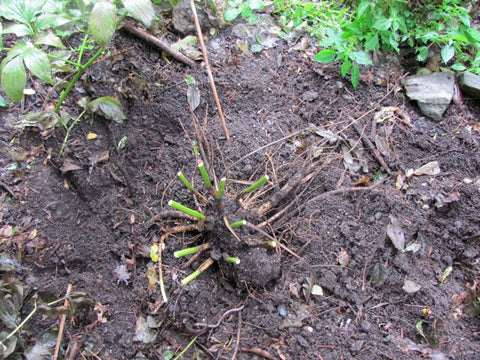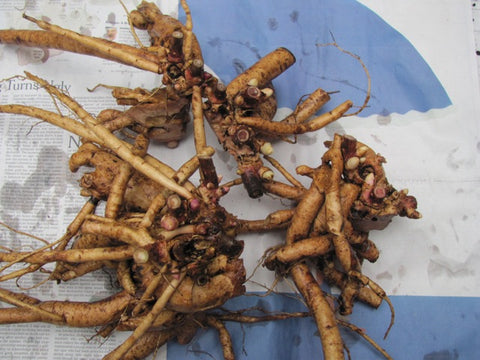Do you have a large, old herbaceous peony clump that you would like to propagate? The best way to do this is through dividing the root system. This is a form of asexual reproduction, and yields a duplicate of the mother plant. Many plants are propagated this way such as hosta, iris and daylilies. Planting the seeds from a favorite peony variety is sexual reproduction and this will yield new plants which may not share the same attributes as the mother plant.
The time for digging and dividing herbaceous peonies is late August through early November.
Dividing herbaceous peonies is fairly straight forward process with an end result that will gladden any gardener; more beautiful peonies to spread around the garden or share with friends.
 By early fall, herbaceous peonies are not looking their best.
By early fall, herbaceous peonies are not looking their best.
First cut the stems down, but leave 8” of stem to aid in pulling the roots out of the ground.

Dig around the ‘drip line’ of the peony. For a large clump, this is at least 15” away from the center of the plant. We like to use a heavy duty fork, but a shovel will also do just fine.

Get your digging tool under the root system and gently pry. Do not be impatient to get it out of the ground. Take the time to dig around the clump a few times to loosen the soil and the roots.

Use the stems to ease the roots out of the ground.

Rather than pulling straight up, work it from the sides. Freshly dug peony roots are very brittle.

Dispose of old peony leaves outside of your garden. If you leave them to compost in the garden, any harmful fungi on the leaves will colonize in the compost and only spread further in the garden next year. Old peony leaves can also be burned.

Thoroughly wash off the root system. Cover with a damp towel or tarp and allow to sit overnight. This will soften up the roots and make the task of dividing much easier.
Dividing a herbaceous peony
 Peony dividing tools and supplies.
Peony dividing tools and supplies.
Supplies:
- Isopropyl alcohol and paper towels for sterilizing dividing tools
- Garden clippers
- Assortment of old knifes of various sizes; a paring knife and large cutting knife do well
- Linoleum knife
- Rubber Mallet
After letting your roots soften overnight, begin by cleaning up the remaining stems so you can see the eyes and how the roots intertwine. The ‘eyes’ are the bullet shaped pink buds which grow from the crown of the plant. Each ‘eye’ represents a stem and potentially flowers for next year.
In order to grow well, a new division needs ample roots. Too many eyes with just a little root will be unbalanced and struggle to thrive.
Use the large knife with the aid of the mallet to make your first big cuts.
Make further cuts as necessary with a smaller knife.
After making your cuts, gently pry the pieces apart, carefully untangling the roots.
Cut off any roots with black spots.
Use the linoleum knife to further clean any lesions on the divisions.
Four new peonies out of one. These could be further divided, but we like to have at least 4 eyes per division, suggested minimum is two. New divisions may or may not flower the following spring, depending on the amount of root present. If there are flowers, most likely they will be significantly smaller than a the plant will produce after 2-3 years of undisturbed growth.
If all this seems a bit to much for you, there is the more primitive, but also effective method I like to call the “old farmer technique” of dividing herbaceous peonies.
 Dig up clump.
Dig up clump.

Take good aim with a sharp shovel….

The results are not as precise but the process certainly more expeditious.
Now its time to plant your new divisions. Remember that the ‘eyes’ should be no more than 2” beneath the soil (shallower in warmer climates). Check back next week for a post on planting herbaceous and tree peonies.
‘Itoh’ or intersectional peonies are also propagated by division. Since the crowns of these hybrids are very dense and woody, its best to let them dry out for at least a day before attempting to divide.
 Dig up clump.
Dig up clump.
 By early fall, herbaceous peonies are not looking their best.
By early fall, herbaceous peonies are not looking their best.






 Peony dividing tools and supplies.
Peony dividing tools and supplies.








